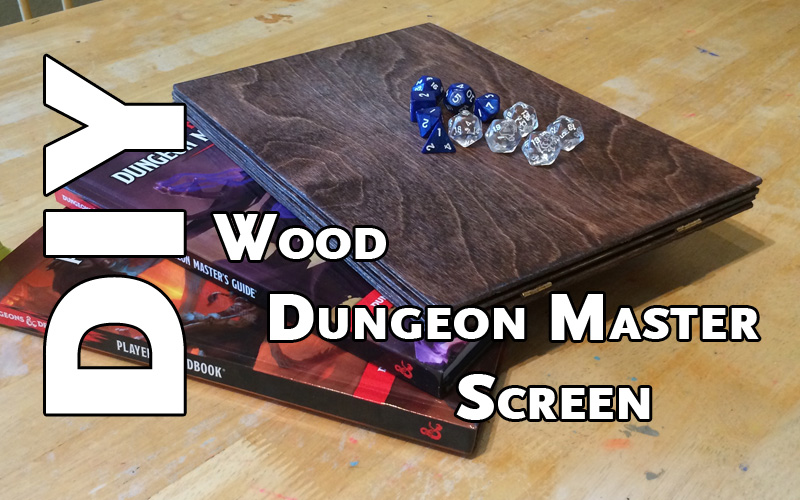I set out to make a custom, dare I say elegant, Dungeon Master screen. As always, I start by researching what others had done so I created a Pinterest board to collect them. I quickly discovered what I liked and didn’t like about these various designs, which helped me come up with my own objective list.
Want:
- Wood – I wanted the elegance of a natural look when I had no player-facing art to display
- Folds – It needed to stack easily and compactly with other materials
- Swappable cheat sheets – adventure-specific ones and/or a library of general ones
- Swappable player-facing art – Inspiring art, maps, reference charts
- Landscape orientation – Lower profile so I can sit comfortably and still see the players easily
- Magnets – embedded to hold artwork on both sides, holds it together when stored
- (some day) Artwork – burned or carved in the wood when adventure-specific art is not available.
Don’t Want:
- Built-in dice tower – it adds too much bulk, and I’m not a fan of using them
- Bulky – 1/2″ or 3/4″ thick plywood looks clunky instead of elegant, and storage is unnecessarily too large
- Pocket Protectors – A simple solution and effective for holding cheat sheets and art, but they just look cheap
Parts List:
- 4x 12″x12″ craft plywood 1/8″ thick – $18 total
- 3x small boxes (take the hinges) – $3 total
- 4-pack of neodymium magnets – $4.50
- MinWax Wood Conditioner – $6
- MinWax Red Oak Stain – $5
- MinWax Polyurethane Satin – $7
Project Total: $43.50 Very reasonable for a beautiful, multi adventure, RPG-agnostic DM/GM screen.
Assembly
I purchased 4x pieces of 12″ x 12″ 1/8″ craft birch plywood from my local Michael’s store. 12″ was good for length, but the width needed to be cut down to 9″ to be a 12″x9″ landscape orientation

12″ x 12″ birch plywood (1/8″ thick)
First I aligned the grain of them so they all flowed left to right (my preference, yours may vary), then stacked them together and bound them with tape… yeah, I know that seems strange, but it prevented splintering while cutting. I ran a band of tape around the wood bundle right where the cut would be made at 9″. This plywood was very thin and the blade on the circular saw was very coarse. Cutting them all at the same time prevented splintering from the wood sandwiched in the middle, and the tape prevented splintering on the outside pieces. It worked very well.
I now had 4x pieces that were 12″ x 9″ that I could lay out side by side in landscape format. You could just as easily put them in portrait format if you wanted to. Next was attaching them together.
Hinges
I purchased 3 small wooden boxes at Michael’s for $1 each. I only wanted the hinges, but they didn’t sell them separately and these boxes were cheap enough to get the job done. I took the 3 sets of hinges off and set them aside.
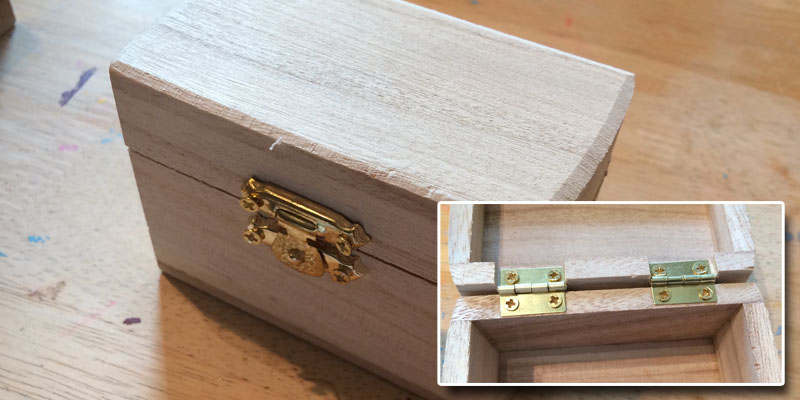
Taking the hinges from inexpensive wooden boxes.
I put two pieces of the wood together, and used a small piece of tape folded over as a 1/16″ spacer. The spacer was to ensure there was enough play in the hinges for it to open and close fully. I then inset the hinges about 2″ from the top/bottom, aligned them across the gap, and marked the holes carefully with a pencil. After pre-drilling the holes, I screwed them in with a small screw driver… presto.

Mounting the hinges with a spacer
After making two of these hinged panels, I now needed to connect the them together. When it folded up, I wanted the wood to “accordion” in on itself. For this to work, I needed to install the hinges for the middle joint on the opposite side of the other hinges. This allows the center hinge to pivot away from me, and the outside hinges to pivot towards me, folding into a perfect book size.

The hinges installed to show the rough assembly of the DM screen.
Screw Problem
After all the hinges were in place, something was obvious… the screws were too long and stuck out the back side of the wood. I grabbed a Dremel tool and grinded the tips down until they were flush with the wood. Problem solved.

Before and After shots of the screw protrusion problem.
Mounting the Magnets
To hold the cheat sheets on the DM side, and the artwork on the player’s side, I decided to go with strong neodymium magnets. The wood was only 1/8″ thick, and the magnets were that thick as well. If I wanted to mount them flush to the wood, I would have to drill completely through the wood. This would only mean the magnets would only have contact with the wood around the circumference. These magnets are strong, and I knew they would easily rip out if mounted this way.
I needed more contact area between these powerful magnets and the wood. I used a flat-headed Dremel bit to manually cut out a shallow 1/16″ recessed pit for each magnet to sit in. This was a delicate procedure. If I pushed too hard, I could easily push through the thin wooden panel. However, it needed to be deep enough to be recessed into the wood to get a better grip.

Carefully cutting the recessed pockets for the magnets.
Placing the magnets was tricky. If I mounted it the wrong side up, then I would have some magnets repelling each other which would be a disaster. I let the magnets stack naturally, then carefully pulled each one off in succession to lay it in the proper panel facing the right direction. Each time, I kept in mind the facing of the magnet and the facing of the magnet it would be connecting to. This part made me nervous.
Using some rough sand paper, I roughed the backs and sides of the magnets to scratch them up and give them more tack. I wiped down each magnet with isopropanyl alcohol to make sure none of my skin oil would interfere with the bonding. I had some JB Weld left over from another project, and used that to mount the magnets in their designated holes. The holes were not perfect, but the JB Weld filled the area around them making the flawed cuts look less ugly.

Mixing equal parts of the JB Weld resin.
I gave the JB Weld about 30 minutes to cure, to be safe, and then gave it a test run. Whew! It closed up perfectly. Nice! It was now functional, and that was verified by the game I DM’d the next night. Works just as I had hoped. Now time for some finishing.
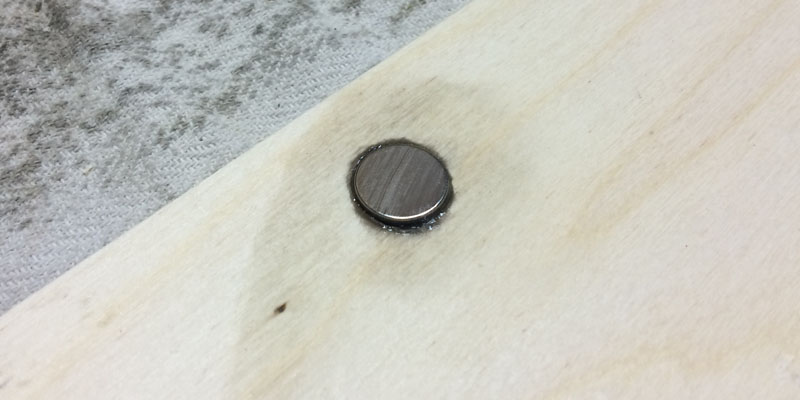
The magnet glued in place.
Finishing
I didn’t take many photos of this process, but there really wasn’t much to see except literally watching the paint dry. However here are the steps I took to finish.
- Sanding – Sand all the panels with 200 grit, then 400 grit sandpaper. Wipe down the wood with a slightly damp cloth to get all the sawdust off the wood.
- Conditioning – I applied a coat of MinWax pre-stain wood conditioner per the instructions. This is a oil-based product, so the stain I applied needed to be oil-based as well.
- Staining – I applied a coat of MinWax Red Oak oil-based stain per the instructions. After wiping off the excess thoroughly, I let it dry overnight per the instructions.
- Polyurethane – Using a 1.5″ brush, I applied a MinWax satin polyurethane oil-based finish per the instructions. This was a very thin coat. After one side had dried for 4 hours, I applied the finish to the other side.
- Final Sanding – I did a light sanding of the whole screen with 400 grid sandpaper, then wiped down the whole thing with a damp cloth.
- Second Coat – I decided NOT to apply a second coat of polyurethane, but later if I apply some artwork I probably will in order to seal in the design.
Final Photos
I’m extremely happy with my final DM Screen! It is functional, and elegant, and meets all of the goals I set out to accomplish. The only task left would be to add some artwork to the panels either carved or burned into the wood. A project for another day.

Any artwork can be easily attached to the screen using a paperclip.

Even if no artwork is on the player side, the natural wood grain is beautiful.
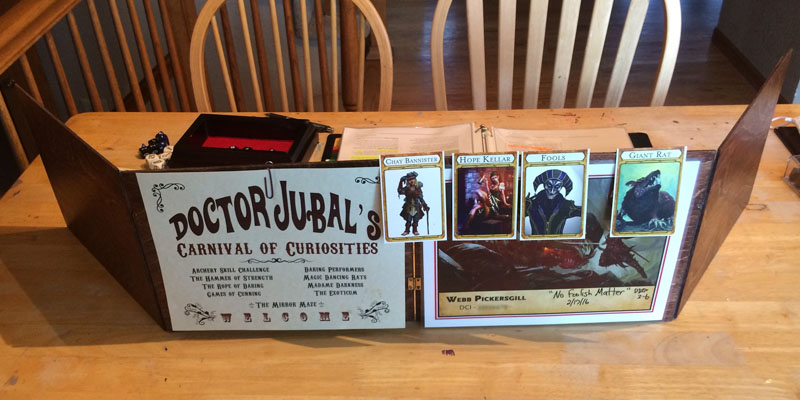
Artwork for the players can be easily swapped out for any adventure.
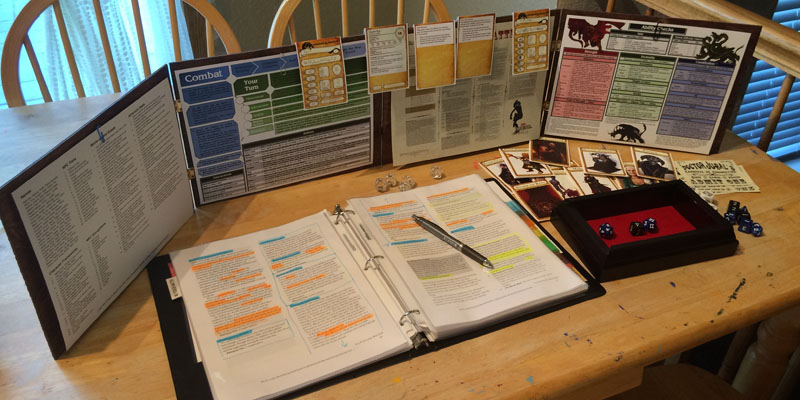
Any cheat sheet can be easily attached on the DM side.

The screen folds to a compact size, and is kept together by the magnets.
About the Author
Webb Pickersgill is a filmmaker and lead cinematic artist in the video game industry. Always looking for a story to tell, he loves to DM a fun game of D&D. He has been happily married for over 20 years and has three awesome kids Ashley, Trinity, and Zion who he loves to play D&D with.

